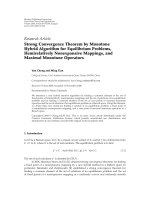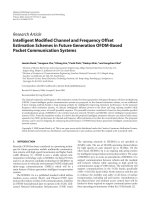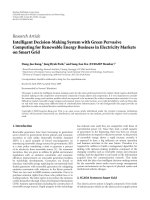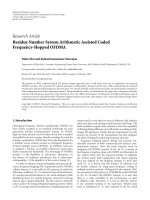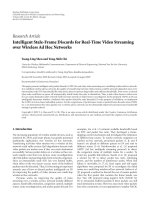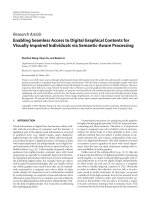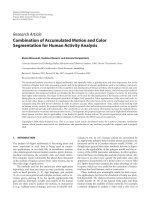Báo cáo hóa học: "Research Article Intelligent Decision-Making System with Green Pervasive Computing for Renewable Energy Business in Electricity Markets on Smart Grid" pdf
Bạn đang xem bản rút gọn của tài liệu. Xem và tải ngay bản đầy đủ của tài liệu tại đây (6.76 MB, 12 trang )
Hindawi Publishing Corporation
EURASIP Journal on Wireless Communications and Networking
Volume 2009, Article ID 247483, 12 pages
doi:10.1155/2009/247483
Research Article
Intelligent Decision-Making System with Green Pervasive
Computing for Renewable Energy Business in Electricity Markets
on Smart Grid
Dong-Joo Kang,
1
Jong Hyuk Park,
2
and Sang-Soo Yeo (EURASIP Member)
3
1
Korea Electrotechnology Research Institute, Uiwang, Gyeonggi, 437-808, South Korea
2
Department of Computer Science and Engineering, Seoul National University of Technology, South Korea
3
Div ision of Computer Engineering, Mokwon University, 302-729, South Korea
Correspondence should be addressed to Sang-Soo Yeo,
Received 6 April 2009; Accepted 8 June 2009
Recommended by Naveen Chilamkurti
This paper is about the intelligent decision-making system for the smart grid based electricity market which requires distributed
decision making on the competitive environments composed of many players and components. It is very important to consider
the renewable energy and emission problem which are expected to be monitored by wireless communication networks. It is very
difficult to predict renewable energy outputs and emission prices over time horizon, so it could be helpful to catch up those data
on real time basis using many different kinds of communication infrastructures. On this backgrounds this paper provides an
algorithm to make an optimal decision considering above factors.
Copyright © 2009 Dong-Joo Kang et al. This is an open access article distributed under the Creative Commons Attribution
License, which permits unrestricted use, distribution, and reproduction in any medium, provided the original work is properly
cited.
1. Introduction
Renewable generators have been increasing in generation
sector driven by government driven policies and economic
incentives to each utility. Renewable Portfolio Standard
(RPS) is a good example of forced encouragement on
introducing renewable energy sources by governments. RPS
is a state policy mandating a state to generate a percent
of its electricity from renewable source [1]. On economic
incentives, they are given to utilities by global environment
regulations such as emission constraints and economic
efficiency improvements on renewable generation facilities
by technology developments. Generators are forced to
introduce renewable energy replacing the conventional fossil
fueled generators with renewable generators for mitigating
emission constraints with reference to the Kyoto protocol.
There are two ways to fulfill emission constraints. One is to
purchase emission rights from those who pollute less or in
trading markets. The other option is to produce the emission
credits themselves through (Clean Development Mechanism
CDM) business opportunities including the construction of
renewable energy sources. Rapid progress in this technology
has reduced costs until they are competitive with those of
conventional power [2]. Since they took a small capacity
of generation in the beginning, there has been no serious
consideration on impacts to the power system. As the portion
of renewable energy shows a rapid increase recently, it
is expected to have a big influence on system operation
and business activities in the near future. Therefore it is
required for utilities to build a management algorithm for
dealing with decision-making problems composed of the
changing variables such as renewable energy and emission
trading. And the algorithm is run based on the information
acquired from the communication network. This study
deals with the idea of an intelligent decision-making system
for the renewable issues under recent energy management
system environments on the aspects of physical system and
institutional scheme changes.
2. SCADA System to Smart Grid
The electric power system is largely composed of two kinds
of infrastructures which are the electric power supply system
2 EURASIP Journal on Wireless Communications and Networking
Generation
Transmission
Distribution
Ve rtically integrated
Genco 1 Genco 2 GencoN
Transco 1 Transco 2
Distco 1 Distco 2 DistcoN
Competition
Unbundling
···
···
Figure 1: Evolution from SCADA system to Smart Grid.
Communication links
(common networks)
Gateway
MODBUS/TCP
DNP over TCP/IP
Serial protocol over
TCP/IP network
DNP or MODBUS
on serial network
Local area or private network
Other
networks
Gateway
Firewall
Corporate
network
MODBUS/TCP
US/TCP
US/TCP
DNP o
over TCP/IP
ov
Figure 2: Smart grid vision [3].
Production cost
Resource assessment
Electricity market price
Emission trading Feed-in tariff
Renewable energy sources
Operation scheduling
Investment planning
Long-term
Short-term
Figure 3: Decision-making process on renewable energy.
and the information infrastructure to control the supply
process. The communication networks of energy systems
are being integrated into other communication networks
and expanded to wide areas for the increasing requirements
of intelligent automation and control while it is currently
confined to the SCADA system that monitors and controls
the power system. One of the big differences from the current
0
20
40
60
80
100
120
1 3 5 7 9 11131517192123
A
B
C
Figure 4: Examples of hourly market price trajectories.
SCADA system is to introduce the end customers into the
interaction in the network, which is illustrated in Figure 1.
As the SCADA system evolves it is expected to be
connected to satellites, sensor networks, the Internet, and
EURASIP Journal on Wireless Communications and Networking 3
Figure 5: User interface example of market simulator.
0
2
4
6
8
10
12
14
Volume (million tonnes CO
2
)
2006-02-06
2006-03-20
2006-05-03
2006-06-15
2006-07-27
2006-09-07
2006-10-19
2006-11-30
15-01-2007
26-02-2007
10-04-2007
22-05-2007
03-07-2007
14-08-2007
25/09/2007
06-11-2007
18-12-2007
01-02-2008
To t a l v o l u m e
Dec08 Sett
ECX CFI futures contracts: price and volume
0
5
10
15
20
25
30
35
Price per tonne (EUR)
Figure 6: ECX CFI futures contracts.
Market price
FIT
Mitig ated FIT
FIT applied period
Mitigated FIT or market price
applied period
Time
Price
Figure 7: Feed-in tariff application.
Prodution cost
Market price
Emission credit cost
RPS
Feed-in tariff
Intelligent
decision-making
system
Operation data
Monitoring by
SCADA system
Alternative 1
Alternative 2
Alternative n
Best option
.
.
.
Figure 8: Intelligent decision-making system.
so forth, in near future. This trend comes to the vision of
smart grid as shown in Figure 2 [3]. Many new concepts
and paradigms are introduced into the smart grid such as
renewable generator operation, demand response, micro-
grid, sensor networks, and so forth. Renewable generators
are not able to be centrally controlled as the way of the
conventional fossil fueled generators. Demand response is
a newly introducing concept for making the markets in
electric power industry. Microgrid is an independent local
power system with a small scale of generators including
renewable energy sources. Sensor networks are installed for
many purposes such as monitoring system status or faults,
assessing renewable resources, and so forth. All these factors
are difficult to be dealt with in central dispatch systems;
therefore it is required to transfer from centrally controlled
structure distributed control scheme.
3. Decision-Making Problem
It is considered five variables such as renewable energy
production cost, potential renewable resource assessment,
electricity market price, emission trading, and government
policy like (feed-in tariff FIT) for the decision-making of util-
ities on the investment planning and operation scheduling of
renewable energy sources. An example process of decision-
making on renewable energy is illustrated in Figure 3 based
on the variables stated above.
Decision-making is no longer a uniquely human func-
tion in complex systems. Indeed, the speed and complexity
of many system processes often preclude the human from
decision and control functions [4]. Especially, the problems
in electric power industry deal with lots of data and variables
which comprises a huge scale of problem with thousands
of variables so that it is inevitable to be supported by
computerized tool on the decision-making process. Sup-
porting decision-making requires understanding of both the
processes involved and the provision of a computer-based
system that supports these processes and allows them to be
carried out more effectively [5]. Renewable energy business
also requires several decision-making processes shown in
Figure 1 considering lots of strategic variables connected
with electric power system as stated above. This study applies
the intelligent decision-making process to the renewable
energy business.
4. External Variables on Renewable Energy
Renewable energy business has several external variables
affecting the decision-making process as shown in Figure 3.
In addition, renewable generators using wind power have
more uncertainties than conventional fossil fueled generators
on output characteristics. There are several critical variables
which are critically considered in guiding decisions on which
energy resources are appropriate for given conditions. The
representative variables are energy and economic efficien-
cies, energy market price paid off for providing energy
with renewable resources. Economic efficiency is about
getting the benefit as much as possible from the same
4 EURASIP Journal on Wireless Communications and Networking
RTU
RTU
RTU
RTU
RTU
RTU
RTU
RTU
RTU
RTU
RTU
RTU
Regional SCADA
server (1)
Regional SCADA
server (2)
Regional SCADA
server (3)
Region: control area
Central SCADA server
RT
U
RTU
R
T
U
R
T
U
Regional SCADA
A
server
(
1
)
Region: contro
l
are
a
Figure 9: SCADA system configuration.
Wind-farm 1
Wind-farm 2
Wind-farm 3
Sub-SCADA 2
Sub-SCADA 3
Sub-SCADA 1
Company-wide
SCADA
Ownership
Communication
Figure 10: Wind farm SCADA system.
productive resources or the same benefit with the least
cost while energy efficiency indicates a narrower concept
of getting the greatest benefit from energy resources. In
market environments resource allocation is guided by the
signals of production costs and market prices. Renewable
energy is mainly transformed into electricity; therefore the
electricity market price is one of important factors affecting
the production and allocation of renewable energy. On
current situation the production cost of renewable energy
is much more expensive than fossil fueled energy so it
is very difficult to expect a fair competition between two
different energy sources. For mitigating the difference on
competitive capabilities originated from production costs,
governments generally support the renewable energy sources
with policy level measures such as RPS and RPS. RPS was
already described above, and feed-in tariff is a pricing scheme
to guarantee renewable capacity developers a minimum price
and power system access rights to promote the development
of renewable energy.
4.1. Electricity Market Prices. Electricity market price is going
to be the most critical factor affecting the profitability of
renewable energy providers in near future while the excessive
production cost above the market price is recovered by
transient policy supports like FIT. Electricity price changes
on real-time basis so it is necessarily required to introduce
stochastic models to reflect the uncertainty of future prices.
Figure 4 shows an example of simulation on electricity
market prices of hourly basis.
These market prices could be forecasted by market
simulators provided by commercial vendors. There are
several popular ones like GE’s MAPS, Henwood’s PROSYM,
Drayton Analytics’ PLEXOS, CRA’s CeMOS, and so forth.
Academic and noncommercial versions have been made
for research purposes using general computerized tools
like MATLAB or GAMS which are also used for making
commercial tools.
4.2. Production Costs. Production cost is another critical
factor with market price for determining the profit of renew-
able energy producers. The production cost of renewable
energy is much higher than fossil fuel, but the gap is
being fast narrowed as the renewable technology advances,
and the environmental costs are added to fossil fueled
generators. So it is very important to assess the exact
production cost reflecting related polices and environmental
cost components like emission costs.
4.3. Resource Assessment. It is a main difficulty in develop-
ing renewable energy sources to assess the exact resource
quantity of renewable energy. For example, wind energy
is very variable according to time and site which also
increases the difficulties on operation and the uncertainties
EURASIP Journal on Wireless Communications and Networking 5
Ethernet hub/switch
Workstation
Radio repeater
RTU
RTU
Offshore wind-farm Onshore wind-farm
Signal processor
Meteorological sensor
(data acquisition)
Private network/internet
Coaxial/optical cable
Radio
communication
Wind-farm SCADA server
Figure 11: Wind farm SCADA system.
Intelligent decision
making system
N-th decision
Analysis on results
(N+1)-th decision
Wind-farm SCADA
Data acquisition
Feedback
Figure 12: Interaction between IDMS and SCADA system.
in business. The resource assessment results become a basis
for determining whether to build wind capacity or not
because the resource quantity directly affects the energy and
economic efficiency at the same time.
4.4. Emission Trading. Since the Kyoto protocol in effect,
the emission constraint has been another cost component
to electric power generating companies. Therefore the com-
panies should make their investment plan on generation
capacity considering emissions because the emission cost
increases the production costs of fossil fueled generating
units. There are two options for generation companies to
fulfill emission constraints. One is to build renewable energy
facilities or work on CDM projects, which is usually long-
term based. The other option is to buy emission credits
from the emission trading markets, which is available on
short-term basis when emission obligations are given at the
Max profit (k, c, t) = revenue − cost
Revenue = (market price or FIT) × supplied energy quantity
+ emission cost savings
Cost = capital cost + O & M cost + opportunity cost
Objective
function
External variables or constraints
• Available capacity of renewable energy facilities
• Lead time for building renewable capacity
• RPS (renewable portfolio standards)
• FIT (feed-in tariff) applied period
Figure 13: Profit function formulization.
year. Emission credits also traded in the market with the
variable market price. Figure 6 shows the changing volumes
and prices of (Carbon Financial Instrument CFI) futures
contracts in the (European Climate Exchange ECX) market
over the time horizon.
4.5. Feed-in Tariff. Feed-in tariffs(FITs)aimtosupport
the market development of renewable energy technologies,
specifically for electricity generation. FITs put a legal obliga-
tion on utilities and energy companies to purchase electricity
from renewable energy producers at a favorable price per
unit, and this price is usually guaranteed over a certain period
6 EURASIP Journal on Wireless Communications and Networking
Electricity market price
(historical data)
Production cost
(assessment results)
Expected mean of
future market price
FIT applied?
Ye s
Renewable capacity
Investment options
RPS
Market price applied
No
1st alternative’s profit = (PP–PC) × RC × CF
2nd alternative’s profit = (PP–PC) × RC × CF
nth alternative’s profit = (PP–PC) × RC × CF
Profit = (MP–PC) × RC × CFProfit = (FIT–PC) × RC × CF
Selecting the best alternative
• FIT: Feed-in tariff
• PC: Production cost
• MP: Market price
• RC: Renewable capacity
• CF: Capacity factor
• PP: Payoff price
Figure 14: Decision-making algorithm for renewable capacity.
Best renewable option
Cost/benefit analysis of
renewable energy
source
Emission costs
Thermal generator
RPS
Fossile-fueled
options
Renewable options
Cost/benefit analysis of
thermal generators
Comparison
Final option selected
Figure 15: Selection between renewable and fossil fuel.
Long-term planning
Short-term operation
Capacity investment, fuel
mix, maintenance, etc
Economic dispatch,
unit commitment, etc
Figure 16: Interaction between long-term and short-term Prob-
lems.
of time [6]. Therefore it is required to consider the cost-
benefit analysis and assess the related risks because FITs do
not last beyond that period. The application period and
price level depend on the government policies which are very
uncertain variables.
5. Strategic Variables on Decision Making
It is required to define the strategic variables for modeling
any decision-making tool and specify the data used for
KPX
EPSIS
IDMS
Market price
available capacity
generation quantity
Fuel mix
settlement price
load forecast
Figure 17: Periodic market data acquisition from EPSIS.
finding out the solution. Strategic variables are defined in the
mathematical formulation and the operation data acquired
from communication channels as input data.
5.1. Intelligent Decision-Making System. Renewable energy
business has several strategic variables for generation com-
panies to maximize the profit and minimize the risk
considering the external variables. According to current elec-
tricity market rules, renewable generators are not centrally
dispatched as nuclear and fossil fueled generators so it is
assumed that there is no strategic variable on operation
mode. Considering investment problems there are several
strategic variables such as the kinds of renewable energies
(solar, wind, geothermal, etc.), the capacity of energy source,
the investment time, and so forth. For simplification these
variables are integrated into an alternative function like
f
n
(k, c, t). So it is considered as the decision-making
problem to decide which one is the best option among given
alternatives. Figure 8 is an example of concept design on
the intelligent decision-making system for renewable energy
investments.
5.2. Acquisition of Data through SCADA system. (Supervisory
Control and Data Acquisition SCADA) is a system operation
with coded signals over communication channels so as to
EURASIP Journal on Wireless Communications and Networking 7
1
45
89
133
177
221
265
309
353
397
441
485
529
573
617
661
705
749
793
837
881
925
969
1013
1057
1101
1145
1189
1233
1277
1321
1365
1409
1453
1497
1541
1585
1629
1673
1717
1761
1805
1849
1893
1937
1981
2025
2069
2113
2157
2201
2245
2289
2333
2377
2421
0
50
100
150
200
250
(Won)
(h)
Figure 18: Electricity market clearing prices.
Price jump by
fuel cost escalation
Price increase
based on inflation
Price increase with inflation
and load growth
Price drop by
a fall of fuel cost
Time
Average
market price
Figure 19: Long-term average price variation.
145
165
187
192
199
204
161
166
172
2009 2010 2011 2012 2013 2014 2015 2016 2017
Ye a r
Average market price (Won/kWh)
Figure 20: Market price scenario.
provide control of (Remote Terminal Unit RTU) equipment
[7]. Recently Intelligent Electronic Device (IED) which is
control unit having communication function with master
station is replacing the role of RTU. SCADA system has
been used for remote measurement and control on the
critical infrastructures such as electric power, gas, and oil
as well as modern industrial facilities such as chemical
factories, manufacturing facilities [8]. SCADA system is
largely composed of three parts of SCADA server, (Remote
82
75
72
69
2009 2010 2011 2012 2013 2014 2015 2016 2017
Ye a r
Production cost (Won/kWh)
Figure 21: Expected production costs of wind energy.
550
500
470
445
2009 2010 2011 2012 2013 2014 2015 2016 2017
Ye a r
Production cost (Won/kWh)
Figure 22:Expectedproductioncostsofsolarenergy.
Terminal Units RTUs), communication links connecting
two terminal parts as shown in Figure 9. Communication
links consist of several kinds of channels on the aspect
of physical media, protocols, topologies, and so forth. Or
all those channels are mixed or interconnected. Originally
SCADA network was a private network exclusive to other
networks or the Internet, but it is getting integrated into the
Internet for more advanced control functions and economic
efficiencies.
8 EURASIP Journal on Wireless Communications and Networking
39
43
91
162
0
20
40
60
80
100
120
140
160
180
(Won/kWh)
Nuclear Coal Oil LNG
Figure 23: Generation costs of conventional thermal generators.
108
107
105
2009 2010 2011 2012 2013 2014 2015 2016 2017
Ye a r
Feed-in tariff (Won/kWh)
Figure 24: Feed-in tariffs applied to wind energy.
720
691
636
2009 2010 2011 2012 2013 2014 2015 2016 2017
Ye a r
Feed-in tariff (Won/kWh)
Figure 25: Feed-in tariffs applied to solar energy.
40,000
22,000
43,000
29,000
19,000
41,500
42,000
39,000
16,500
2009 2010 2011 2012 2013 2014 2015 2016 2017
Ye a r
Emission credit price (Won/ton)
Figure 26: Variable emission credit prices.
9
860
460
689
30
11
0
100
200
300
400
500
600
700
800
900
1000
Emission (g/kWh)
Nuclear Coal LNG Oil Solar Wind
Figure 27: Emission quantities from different energy sources.
0
1000
2000
3000
4000
5000
6000
7000
8000
9000
10000
(Won/kWh)
2009 2010 2011 2012 2013 2014 2015 2016 2017
Oil
LNG
Coal
Wind
Solar
Nuclear
Figure 28: Emission costs on energy sources.
Operation data are collected from the (Supervisory
Control and Data Acquisition SCADA) system also for
renewable energy sources. Wind power is the representa-
tive one among renewable energy sources. Assuming the
wind power, the company-wide SCADA system consists of
several sub-SCADA system monitoring wind farms locally
distributed over wide areas as shown in Figure 10.
Operation data acquired from SCADA system are used
for the resource assessments and operational characteristics
which are references for future investment decisions on
new renewable facilities. Renewable generators are dispersed
over wide area, so various channels are used for the
communication. Onshore wind farms are usually connected
with wire communication methods using coaxial or optical
cables, while offshore wind farms communicate with the
SCADA server on radio channels.
Thedataacquiredfromremotewindfarmsareused
for intelligent decision-making system in Figure 8 and also
reviewed to analyze if the decisions made by the system are
appropriate. If the decision does not match the operation
data then the decision would be corrected for the next period.
Figure 12 shows the interaction process between Intelligent
Decision-making System (IDMS) and Wind farm SCADA
system.
EURASIP Journal on Wireless Communications and Networking 9
−100
−50
0
50
100
150
200
250
(Won/kWh)
2009 2010 2011 2012 2013 2014 2015 2016 2017
Oil
LNG
Coal
Wind
Solar
Nuclear
Figure 29: Profitability on each energy resource.
Power
pool
Wind energy
Solar energy
Thermal plants
Complementary
output
Intermittent
output
Forecasted
load
Controlled
output
Ta rgeted
output
Figure 30: Renewable thermal coordinated operation.
6. Decision-Making Algorithm
It is required to make a mathematical formulation for mod-
eling of intelligent decision-making system as a program-
based tool. Optimization models are generally used for
solving decision-making problems under given resources and
conditions. The optimization model is generally composed
of an objective function and multiple constraints. In this kind
of business related model it is commonly used to maximize
the profitability of the company for the objective function.
Considering the profit maximization, the objective function
of renewable energy business described in Figures 3 and 8
could be formulated as follows.
An example is illustrated in Figure 14, which is about
the decision-making algorithm for choosing the best option
among candidate alternatives based on the optimization
model in Figure 13 to maximize the profitability under given
conditions.
Once the best renewable option selected it is compared
with the fossil fueled generator option on the aspect of
cost/benefit analysis as shown in Figure 15. The one giving
more benefit is selected as the final option.
0
20
40
60
80
100
120
140
160
180
200
1 3 5 7 9 11131517192123
Renewable
Load
Figure 31: Forecasted load and renewable output.
This decision-making algorithm could be modeled with
lots of numerical and heuristic methods. And it could be
reinforced with other mathematical model like game theory
and (artificial intelligence AI) based approaches.
7. Problem Solving on IDMS and Case Study
Traditionally, simulation of business process is used to
support strategic decision-making. In this case, simulation
is used as a tool to analyze long-term effects of certain
decisions. Simulation is rarely used for management control
and operation control, because building a simulation model
takes too much time to evaluate short effects [9]. However
the short-term operation and constraints are critical also
on long-term strategic decision-making problems in the
electric power system because the electricity market should
be operated on the physical system. Therefore it is required
to consider long-term and short-term problems as the
components interacting with each other in a problem.
In this section it is exampled that long-term and short-
term problems are related to renewable energy sources in
electricity market. Economic aspects of renewable source
investments are dealt with in the first long-term problem
section, and operational issues of renewable generator like
coordinated dispatch with other thermal plants in the second
short-term problem section.
7.1. Long-term Investment Problem. Electricity market prices
are published by (Korea Power Exchange KPX) on its
webpage, and those historical data used for forecasting future
market prices. These data could be retrieved from (Electric
Power Statistics Information System EPSIS) periodically as
input data for IDMS.
There are lots of methods and tools for forecasting
the electricity market prices. The most simple and popular
ones are statistics based function provided by spreadsheet
programs, which mostly uses historical data. As more
specialized tools, there are several computerized tools for
electricity market simulation provided by commercial ven-
dors. Figure 18 shows the electricity market prices recently
published by KPX (Korea Power Exchange) for one month
10 EURASIP Journal on Wireless Communications and Networking
Energy management system
SCADA server
MTUs (regional SCADA servers)
RTUs (each at a substation)
Generating
stations
ICCP
ICCP
TCP/IP
DNP
DNP
DNP/TCP/IP
ICCP
IED
MOUBUS, Harris, FIELDBUS, DNP (→IEC61850)
Figure 32: Data exchange between SCADA and EMS.
0
20
40
60
80
100
120
140
160
1 3 5 7 9 11131517192123
Figure 33: Net load offset between load and renewable output.
of March in 2009 [10]. The average price for the month is
145[Won/kWh].
One month is not a long-term in electricity market and
it shows any increasing or decreasing trend in Figure 18.
The average price could be used for future investment plan
by reflecting the load growth and the inflation rate as a
simple scenario that there is no change on fuel costs and
fuel mix ratio. When there is capacity investment or fuel cost
variation, the long term market prices could go down as well
as up.
A scenario about the market price is assumed as shown
in Figure 18 for the case study based on the concepts given in
Figures 18 and 19. The product costs of wind power energy
are variable dependent on the wind resource quantity and the
load factors of the wind generators, so it is quite difficult to
quantify the unit cost per unit energy (kWh). However it is
required to do economic assessments.
Production costs are applied like in Figures 21 and 22 in
this case study, which are similar with the current cost levels
of renewable energy production in Korea. As the technology
advances the unit cost of renewable energy production is
expected to decrease year by year. Figure 23 shows the
generation costs of conventional thermal generators.
Feed-in tariffs are temporal measures for supporting the
introduction of renewable energy sources until they have the
economic competitiveness compared to conventional fossil
fueled generators. The purchasing prices are applied to wind
and solar energy resources in feed-in tariffs at the level of
Figures 24 and 25. The price for wind is discounted 2% every
3 years and solar for 4%.
Feed-in tariffs are uncertain variables determined by
government policies because policy-related variables are very
hard to forecast. Therefore it is required to build various
scenarios on feed-in tariffs to minimize the risks by applying
the wrong payoff price to the profitability estimation of
renewable energy sources.
Emission costs are changing on real-time basis correlated
with the price of emission credits according to the balancing
condition between supply and demand in emission trading
markets. The annually averaged prices are used for this case
study for simplification. And the prices are multiplied by a
multiplier (0.02) reflecting the transient status of emission
costs applied to generation costs.
Theemissionquantity[g]fromeachenergysourceper
unit electricity [kWh] production is illustrated in Figure 25.
Through the emission credit price [Won/ton] in
Figure 26 and the emission quantity [g/kWh] in Figure 27,
the emission cost can be recalculated as the unit [Won/kWh]
in Figure 28.
Considering all the data till now decision-making system
based on the algorithm in Figures 14 and 15 gives the
profitability result of each generation source over time
horizon. This result is based on the assumption given in
the beginning, so the result could be different by another
assumption. However it is expected to be similar to the trend
in which nuclear and renewable energy sources have good
profitability.
Nuclear, solar energy and wind energy show good
profitability compared to other energy resources in Figure 29
and that trend will be stronger as the emission cost loads
are heavier by increasing the multiplier to the value more
EURASIP Journal on Wireless Communications and Networking 11
Wind-farm 2
Wind-farm 1
Power system
Commercial load
Thermal plant 1
Thermal plant 2
Solar-farm 1
Industrial load
Residential load
SCAD
A
RTU
RTU
RTU
RTU
RTU
RTU
RTU
RTU
DTE
SCADA communication network
Local microgrid
Data exchange for coordination
on wireless networks
Metrological sensor
Figure 34: Data exchange for coordination on wireless networks.
than 0.02. Through the automation of this decision-making
process, energy companies are expected to assess multiple
alternatives on renewable investment plans.
7.2. Short-term Operation Problem. Renewable energy
sources as wind power and photovoltaics are intermittent
in production and therefore not always available in the
power supply, when needed. This of course can imply that
conventional power capacity is to be available to compensate
for the missing production from renewable plants [11]. It
is necessary to coordinate the renewable energy operation
with other thermal plants both on economic aspects and
system aspects because thermal plants have the most flexible
ramp rate compared to other energy sources. This has also
been studied in hydrothermal coordination for a long time.
Traditionally, hydrothermal coordination is formulated
as a cost minimization problem, that is, to minimize
the total system cost (usually, the thermal production
cost) [12]. Renewable energy sources have intermittent
supply characteristics more difficult to control compared
to hydroenergy sources. As technology evolves renewable
energy sources have been being more controllable. But it is
not yet enough, so they are also required to be supported by
thermal plants.
It is assumed that load data and renewable outputs are
forecasted as in Figure 30. Load data is forecasted by a
module in (Energy Management System EMS) of KPX and
published at the homepage.
Historical data acquired from SCADA system are used for
load forecast. SCADA system retrieves data from the RTU
installed in each substation. SCADA system and EMS are
also connected with each other’s data exchange based on the
(InterControl Center Communication Protocol ICCP).
Considering the forecasted load and expected renewable
outputs, EMS issues the dispatch order to thermal generators
to meet the net load subtracted by the renewable output from
the originally forecasted load. In the case of Figure 31 the net
load is calculated as shown in Figure 33.
The net load is supplied by thermal generators consid-
ering the uncertainties and up/down ramp rates of thermal
generators. There are two uncertain variables on this process.
One is forecasting errors in load forecast, and the other is in
renewable output. Therefore it is required for system oper-
ator or generation companies to be updated with real-time
information and thereby follow the net load variation. The
information is mainly collected from SCADA system, but it
is recommended to acquire from many other metrological
sensor devices for predicting renewable resources. Wireless
sensor networks seem very appropriate for this purpose on
the aspect of power supply. Energy conservation plays a
crucial role in wireless sensor networks since such networks
are designed to be placed in hostile and nonaccessible
areas. While battery-driven sensors will run out of battery
12 EURASIP Journal on Wireless Communications and Networking
sooner or later, the use of renewable energy sources such
as solar or gravitation may extend the lifetime of a sensor
[13]. Interaction and coordination between generators could
mitigate the uncertainties caused by intermittent property
of renewable energy sources based on information acquired
periodically from the existing SCADA system and wireless
networks.
The data collected from various network routes are
analyzed and used for IDMS for optimal decision-making on
short-term operational problems.
8. Conclusion
Renewable generators are increasing in electric power
industry with many incentives on green technologies and
environmental regulations. This process is globally driven
by governments, which causes many uncertainties on the
aspects of physical system operation and electricity market
business activities. In addition, electricity markets are inter-
connected with other business area like emission trading
markets, and thereby the system is getting complicated as
time goes on. Furthermore the system is required to be
operated on real-time basis, so it is almost impossible for
humans to make a decision on the huge scale of problem
at every moment. This paper tries to propose a concept of
an intelligent decision-making system to solve that kind of
problem with renewable investment and operational issues
instead of humans. For that purpose it is needed to have
its own intelligent decision-making algorithm independent
of humans. The last section introduced the application
concept and example of IDMS to the long-term decision-
making problem related to investment issues and short-
term one about operational issues, respectively. It is expected
to deal with more detail algorithms for modeling IDMS
such as game theory, genetic algorithm, and so forth. The
IDMS could be helped by distributed sensor networks for
collecting information and monitoring the recent status
on the aspect of physical system infrastructures. And
the battery problem for the sensor networks is solved
by renewable energy sources dispersed over wide areas,
which comes to the concept of green pervasive comput-
ing.
References
[1] R. Singh and Y. R. Sood, “Policies for promotion of renewable
energy sources for restructured power sector,” in Proceedings of
the 3rd International Conference on Electric Utility Deregulation
and Restructuring and Power Technologies, pp. 1–5, Nanjuing,
China, April 2008.
[2] D. C. Quarton, “The evolution of wind turbine design
analysis—a twenty-year progress review,” in Wind Energy, vol.
1, pp. 5–24, John Wiley & Sons, New York, NY, USA, 1998.
[3] />658688.
[4] R. J. Martel and J. J. Sudano, “Information optimization
for decision making,” in Proceedings of the IEEE National
Aerospace and Electronics Conference (NAECON ’97), vol. 1,
pp. 454–461, Dayton, Ohio, USA, July 1997.
[5] M. A. Hersh, “Sustainable decision making: the role of
decision support systems,” IEEE Transactions on Systems, Man
and Cybernetics Part C, vol. 29, no. 3, pp. 395–408, 1999.
[6] .
[7] D J. Kang and H M. Kim, “A proposal for key policy of
symmetric encryption application to cyber security of KEPCO
SCADA network,” in Proceedings of International Conference
on Future Generation Communication and Networking (FGCN
’07), vol. 2, pp. 609–613, Jeju, Island, December 2007.
[8] G. Clarke, D. Reynders, and E. Wright, Practical Modern
SCADA Protocols, Newnes, Oxford, UK, 2004.
[9]H.A.ReijersandW.M.P.vanderAalst,“Short-term
simulation: bridging the gap between operational control
and strategic decision making,” in Proceedings of the IASTED
International Conference Modeling and Simulation (MS ’99),
pp. 417–421, May 1999.
[10] .
[11] P. E. Morthorst, “Assessment and optimization of renewable
support schemes in the European electricity market,” Work
Package 6 Interactions with Other Policies and Markets, RisΦ
Laboratory, 2006.
[12] Z. Yu, F. T. Sparrow, and D. Nderitu, “Long-term hydrother-
mal scheduling using composite thermal and composite hydro
representations,” IEE Proceedings: Generation, Transmission
and Distribution, vol. 145, no. 2, pp. 210–216, 1998.
[13] T. Voigt, H. Ritter, and J. Schiller, “Utilizing renewable
energy in cluster-based sensor networks,” in Proceedings of
the 1st Swedish National Computer Networking Workshop,
Arlandastad, Sweden, September 2003.
